As far as we know, the plant kingdom has not developed its own genre of productivity literature. There is no plant equivalent of Six Sigma, GTD, or Lifehacker — an absence made all the more alarming by the recent discovery of the existence of a subterranean plant “internet.”
The result? Despite being the main thing plants do all day, photosynthesis is “relatively inefficient,” according to Devens Gust, the professor in charge of the Center for Bioenergy & Photosynthesis at Arizona State University:
For example, based on the amount of carbon fixed by a field of corn during a typical growing season, only about 1-2% of the solar energy falling on the field is recovered as new photosynthetic products. The efficiency of uncultivated plant life is only about 0.2%. In sugar cane, which is one of the most efficient plants, about 8% of the light absorbed by the plant is preserved as chemical energy.
Given that photosynthesis is the direct or indirect source of all human food, this kind of slacking is clearly just not good enough. After all, a more photosynthetically efficient strain of wheat could yield 50 percent more grain than its current incarnation, even under more the crowded, dry, and hot conditions that seem likely to predominate in our climate-changed future.
Fortunately, scientists are hard at work staging an intervention. Unfortunately, as a confused Melvyn Bragg complained in a fascinating BBC radio programme on the topic, with photosynthesis, “the simpler you make it, the more mysterious it also gets.”
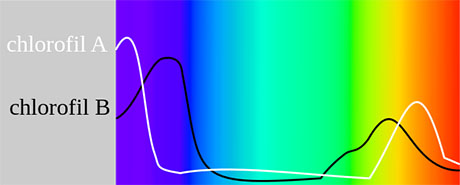
IMAGE: Absorption of light by chlorophyll, Holak Lewińki.
Take, for example, the fact that it’s possible that plants are actually the wrong colour, at least in terms of photosynthetic efficiency. As attractive as green fields and forests are to the human eye, to those in the know, they represent a scandalous waste of sunlight.
Plants are green because chlorophyll reflects, rather than absorbs, the middle of the light spectrum. Chlorophyll powers the photosynthetic reaction by absorbing and transferring energy from light, but, according to Nick Lane, an evolutionary biochemist speaking on Melvyn Bragg’s programme, it only absorbs blue and red light — and, worse yet, it only actually bothers using the red stuff, which is the lower energy of the two.
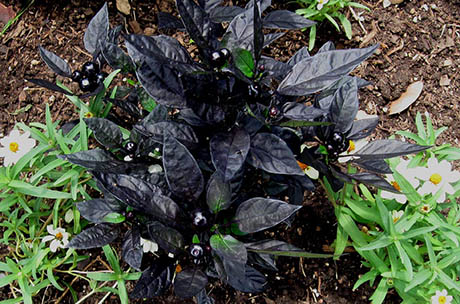
IMAGE: Black plants are extremely rare, for now. Photo via.
True efficiency, at least in terms of total spectrum absorption, would require black leaves, rather than green. However, it seems as though most plants are somewhat resistant to this simple but radical dietary hack, and for reasons that are not well understood: the prevailing theory is that higher-energy wavelengths of light are just too hot to handle, damaging a plant’s photosynthetic machinery.
Not to be defeated, a recent study looking at light usage in leaves proposed that, if re-engineered to produce a kind of internal antioxidant (a protective carotenoid called siphonaxanthin), plants “could close the so-called ‘green window’ and increase their absorptance” — and thus, one hopes, their yield.
Another toughening-up approach focuses on tweaking a plant’s in-house repairman, the D1 protein, so that it can rebuild light-damaged photosynthetic machinery more quickly and efficiently. For example, last year, an international team of scientists sent algae samples for a two-week holiday in space in order to see whether bombardment with cosmic radiation might produce a D1 with super-healing powers. Apparently, two mutant strains showed particular promise both in space and on earth, and now form the focus of future research.

IMAGE: (L) Preparing to launch the mutant algae into space at Baikonur Cosmodrome; (2) The capsule full of algae, returned to Earth somewhere in Kazakhstan. Photos from “Taming Extreme Environments by Exploring Algae in Space,” Agricultural Research magazine.
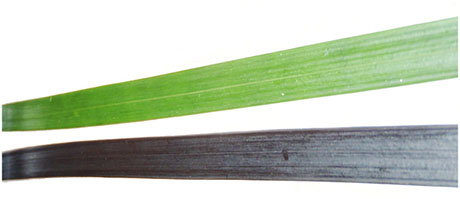
IMAGE: Photograph of portions of green and black leaves of Ophiopogon planiscapus ‘Nigrescens,’ as compared in “The Functional Significance of Black-Pigmented Leaves: Photosynthesis, Photoprotection and Productivity in Ophiopogon planiscapus ‘Nigrescens’” by Jean-Hugues B. Hatier, Michael J. Clearwater, and Kevin S. Gould.
Frustratingly, however, in the only known study comparing the photosynthetic efficiency of one of the few naturally occurring black-leaved plants with its green cousin, researchers at the University of Auckland found that two were equally productive. Despite containing high levels of protective flavonoids, the full-spectrum plants had no edge on their light-wasting relations. More study is needed, it seems, before turning our emerald planet black.
A potentially more promising direction for plants seeking to improve their productivity (and for the humans trying to encourage them) is to copy the habits of those plants that are already highly effective.
Roughly 7,600, or three percent, of plant species have evolved a more efficient photosynthetic process than the rest, based on how much carbon they can absorb. Among these so-called C4 plants are corn, sugar cane, and a lot of cacti; their less efficient C3 counterparts include rice, wheat, and the rest of the world’s major food crops.
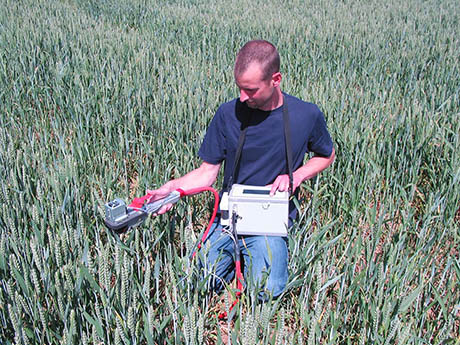
IMAGE: Measuring the photosynthetic efficiency of wheat. Photograph by Steveadcuk.
As Natural History Museum chief botanist Sandra Knapp explained to Melvyn Bragg, “one of the great holy grails in agriculture is to take a C3 plant, like rice or wheat, and turn it into a C4 plant, which would increase its efficiency and thereby perhaps its yield.”
In hot, dry environments, C4 plants use less water and nitrogen that their C3 colleagues, while yielding half as much food again. The Economist spells these numbers out: “a hectare of rice, a C3 plant, produces a harvest of no more than eight tonnes, whereas maize, a C4 plant, yields as much as twelve tonnes.”
In the Philippines, scientists at the International Rice Research Institute (IRRI) starting the process of creating a C4 rice in 2009. At the moment, apparently, they’re still in the process of listing which genes in C4 plants are involved in efficient photosynthesis.
Among other, more high-tech and less brutal methods, this relies on the Shark Tank-like technique of knocking out one gene at a time, and then growing the plant in a low-CO2 chamber. Thanks to their superior carbon-absorbing skills, C4 plants can get by with CO2 levels as low as 15 ppm (for comparison, Earth’s atmosphere has passed 400 ppm already).
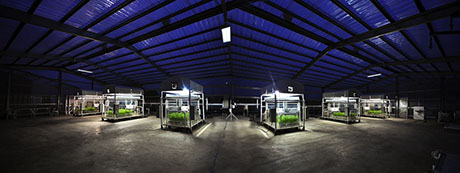
IMAGE: Low CO2 growth chambers at IRRI.
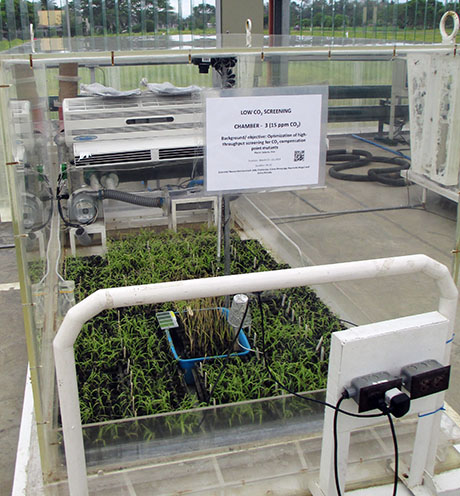
IMAGE: Low CO2 growth chamber, IRRI, photograph by R. Ford Dennison.
But, if the missing gene turns out to have been necessary to C4 photosynthesis, the newly inefficient plant will die. IRRI hopes to be able offer growers a transgenic C4-version of their local rice varieties by 2026.
Though scientists seem to be more than a decade away from a successful formula for increasing plants’ light- or CO2-absorption abilities, something about these descriptions can’t help but conjure up a visceral vision of the jet-black, no-nonsense, Shark Tank-survivor salad leaves of the future. Today’s superfoods — açaí berries, chia seeds, and that deceptively green wheatgrass — better watch their backs: the highly efficient plants of the future are coming…
See also Designing a Restaurant for Plants: An Interview with Jonathon Keats.

Forget C3 and C4 photosynthesis, give me CAM photosynthesis baby!
Oh and to Curtis, it’s the same cosmic radiation you’re subjected to when you walk outside each day. Black plants would just absorb the middle range of the visible spectrum (a.k.a. green – where the sun transmits most of its energy).
Forget C3 and C4 photosynthesis, give me some CAM photosynthesis baby!
So if I put down a purple garden covering, that would help my plants? I’ve seen red coverings, but they clash with my hummingbird feeders….the purple would just be peachy!
Hope this is the case!
Maybe photosynthesis is the LEAST of what plants do with sunlight…will we ever know before someone is funded by god knows who to change all the roses from white to red??? lol
This post may be tongue in cheek but scientists unfortunately actually think these types of thoughts. Human arrogance is one of the factors that shall soon render us extinct unless science cultivates some serious consideration and respect for the wisdom of a natural process that freaking created US.
They are green so that they absorb the UV and IR spectrum most harmful to humans.
Black plants! Apart from absorbing too much radiation and overheating, how would the taste be affected? For leafy vegetables, the thought of a “black” leaf lettuce doesn’t sound too appetizing.
Agreed, but this post is a slightly tongue-in-cheek look at how we humans are trying to make plants “more efficient” (a term that is open to debate in the first place), rather than an analysis of the most promising methods for increasing yield worldwide.
But ‘all things’ are never equal, and conditions should be part and parcel of any analysis. I just think that focusing on that aspect of production is overly reductionist and not too helpful, and perpetuates the myth (that many stubbornly cling to, either consciously or not) that technology can provide silver bullet solutions.
The numbers are from The Economist magazine. Clearly production methods (and soil health, and weather conditions, etc.) make a huge difference to yield. The point is that the yield of C4 crops is, all other things being equal, roughly 50 percent more than that of C3 crops.
“a hectare of rice, a C3 plant, produces a harvest of no more than eight tonnes, whereas maize, a C4 plant, yields as much as twelve tonnes.”
I appreciate the distinction between C3 and C4 plants, but that rice yield number is wrong. Production methods can make a huge difference. Empirical evidence shows that SRI (System of Rice Intensification) methods can produce huge yield increases. So, it would be appropriate to edit your text, or provide a caveat through a footnote.
It’s an interesting question. It’s possible that increased production of flavonoids (to help increase photosynthetic efficiency) would benefit us. But I don’t know whether there would be other human health effects.
They’re just using that method as a test to detect whether the gene/s they have knocked out is actually essential to C4 photosynthesis, so that they can develop a list of the genes involved in C4 photosynthesis and then insert them into C3 plants. In fact, C4 plants sequester more carbon than C3 plants: according to this paper, they account for 30 percent of global terrestrial carbon fixation, despite consisting of only 3 percent of all plants.
C4 may not be *as* efficient as CO2 levels rise, however, thought it will likely still be more efficient than C3.
The shark tank method seems … Unhealthy for earth. If they spread plants that requier LESS Co2… how are we supposed to get rid of the huge amount of co2 that is poluting our air !?
but what would that do to us, as we eat these foods? the added radiation?